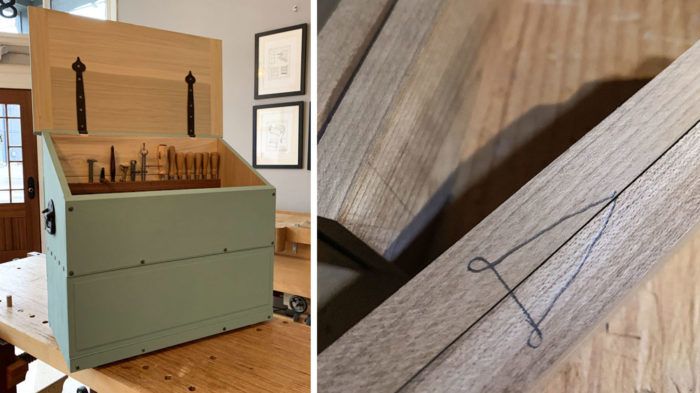A Marriage of Multiple Methods
In her classes, Megan Fitzpatrick preaches that there is (almost) always more than one way to do anything
The one lesson I preach ad nauseam in woodworking classes is that there is (almost) always more than one way to do anything. (OK, two lessons: the above, and YOU WILL USE MARRIAGE MARKS.) So I do my best—particularly in longer classes when time allows for it—to demonstrate multiple methods to achieve the desired outcome.
In June, I taught a weeklong Dutch tool chest class at the Port Townsend School of Woodworking, in which I’d promised we’d do breadboard ends on the tops. Unlike in my shorter hand-tool classes on the same subject—for which I prep the stock as a kit build then concentrate on teaching dovetails and dadoes—the raised panels on the fall fronts and lids were not raised, the lids were still oversize in every dimension, the backboards had neither rabbets (for shiplap joints) or tongues and grooves (either joint works fine for the backs of these chests). I figured with two extra days in the schedule, we could do all that in class and learn a few more techniques.
For dadoes, we chose from among:
•Batten clamped to layout lines to guide a crosscut saw, then knock out waste with a chisel, followed by a router plane for smooth bottoms
• Battens, saw, and chisel, no router plane
• Knifed-in layout lines, chisel a V-cut to the lines (in the waste, of course!), then pare the remaining waste (router plane optional)
• Freehand sawing to baseline, waste removal method of choice
For raising the panels, we tried:
• Skewed and fenced rabbet plane (and moving fillister)
• Batten clamped to layout line with a straight rabbet plane registered against said batten
• Sawing to baselines, then paring the (small amount of) waste with wide chisels, followed by a router plane or rabbet plane to clean up as needed
• Well-knifed layout lines, then tipping a shoulder plane into the knife line, lowering it with each pass (to create a wall against which the plane’s sharp shoulder registers) until it’s cutting flat and the baseline is met
For the backboards, I was more limited (how I wish I’d brought my Stanley 48!). We tried out:
• Wooden match planes (aka tongue-and-groove planes)
• Plow planes and rabbet planes
• And…confession: We offered the option of a slot cutter in the shaper for the grooves (we were running out of time and available tools)!
As Thursday came to a close, the backboards were nailed on, and everyone was putting the final touches on their carcases and fall fronts. We were running short on time to get the lids done, so I began to extol the traditional look and robustness of a lid with battens on the outside edges. It seems I suck at selling; there were no takers. Breadboard ends for all.
But that was OK – they’d already learned how (several hows, in fact) for the tenon half of the joints. I sketched out the joinery on the whiteboard, then asked them to teach me how to cut it. To a one, they drew on what we learned in the previous four days, and applied that to a new end, and not everyone chose the same method (sniff – I’m so proud!). Then Raphael Berrios (my assistant for the class, a graduate of the school’s intensive program, and an excellent woodworker) and I showed our approaches to chopping mortises, and they were off.
There was still some finishing and cleanup for folks to do at home (as well as paint and hardware), but everyone left with the skills and experience to do it.
But most important to me is that everyone also left with the knowledge that there is more than one way to skin a rabbet—and that is the best lesson I can teach. (Along with staying true to your marriage marks.)

P.S. In my brief rundown of methods, I know I missed a few options (feel free to add them in the comments)—a dado plane, for example, for dadoes (would that I owned one).
Megan Fitzpatrick is the publisher at Rude Mechanicals Press and a peripatetic woodworking instructor and freelance writer/editor. She lives in Cincinnati where she’s renovating a 1905 house, but can usually be found in the Lost Art Press shop in Covington, Ky.
















Comments
It's great reading your work. you write in such away that it is very easy to follow and understand. keep up the great job and I look forward to reading more from you.
Thanks!
Log in or create an account to post a comment.
Sign up Log in